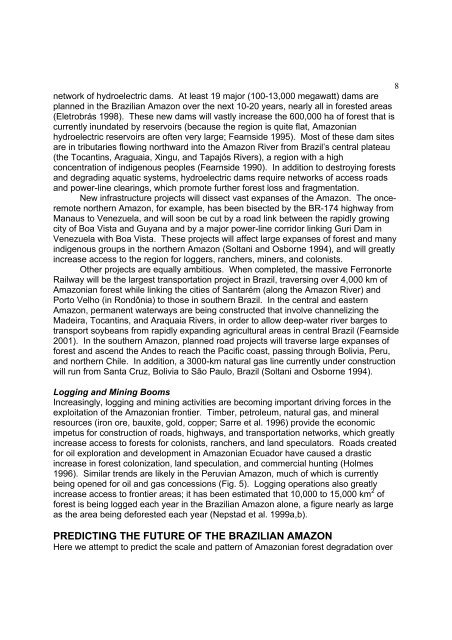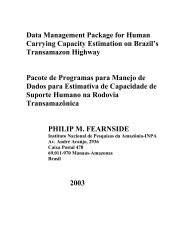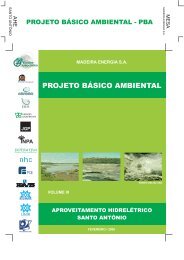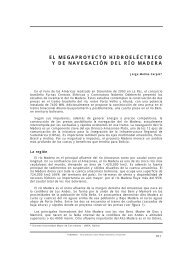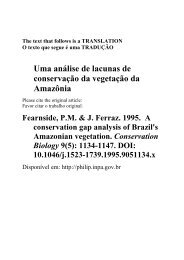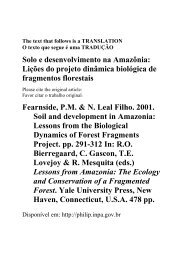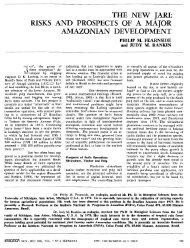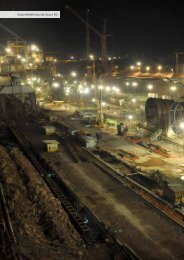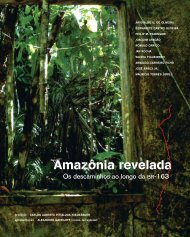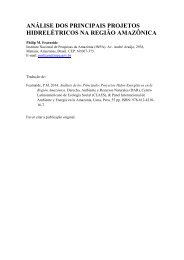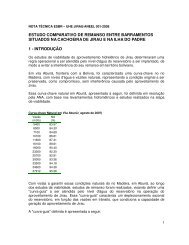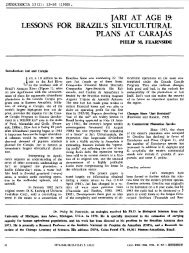THE FUTURE OF THE AMAZON - Philip M. Fearnside - Inpa
THE FUTURE OF THE AMAZON - Philip M. Fearnside - Inpa
THE FUTURE OF THE AMAZON - Philip M. Fearnside - Inpa
You also want an ePaper? Increase the reach of your titles
YUMPU automatically turns print PDFs into web optimized ePapers that Google loves.
8network of hydroelectric dams. At least 19 major (100-13,000 megawatt) dams areplanned in the Brazilian Amazon over the next 10-20 years, nearly all in forested areas(Eletrobrás 1998). These new dams will vastly increase the 600,000 ha of forest that iscurrently inundated by reservoirs (because the region is quite flat, Amazonianhydroelectric reservoirs are often very large; <strong>Fearnside</strong> 1995). Most of these dam sitesare in tributaries flowing northward into the Amazon River from Brazil’s central plateau(the Tocantins, Araguaia, Xingu, and Tapajós Rivers), a region with a highconcentration of indigenous peoples (<strong>Fearnside</strong> 1990). In addition to destroying forestsand degrading aquatic systems, hydroelectric dams require networks of access roadsand power-line clearings, which promote further forest loss and fragmentation.New infrastructure projects will dissect vast expanses of the Amazon. The onceremotenorthern Amazon, for example, has been bisected by the BR-174 highway fromManaus to Venezuela, and will soon be cut by a road link between the rapidly growingcity of Boa Vista and Guyana and by a major power-line corridor linking Guri Dam inVenezuela with Boa Vista. These projects will affect large expanses of forest and manyindigenous groups in the northern Amazon (Soltani and Osborne 1994), and will greatlyincrease access to the region for loggers, ranchers, miners, and colonists.Other projects are equally ambitious. When completed, the massive FerronorteRailway will be the largest transportation project in Brazil, traversing over 4,000 km ofAmazonian forest while linking the cities of Santarém (along the Amazon River) andPorto Velho (in Rondônia) to those in southern Brazil. In the central and easternAmazon, permanent waterways are being constructed that involve channelizing theMadeira, Tocantins, and Araquaia Rivers, in order to allow deep-water river barges totransport soybeans from rapidly expanding agricultural areas in central Brazil (<strong>Fearnside</strong>2001). In the southern Amazon, planned road projects will traverse large expanses offorest and ascend the Andes to reach the Pacific coast, passing through Bolivia, Peru,and northern Chile. In addition, a 3000-km natural gas line currently under constructionwill run from Santa Cruz, Bolivia to São Paulo, Brazil (Soltani and Osborne 1994).Logging and Mining BoomsIncreasingly, logging and mining activities are becoming important driving forces in theexploitation of the Amazonian frontier. Timber, petroleum, natural gas, and mineralresources (iron ore, bauxite, gold, copper; Sarre et al. 1996) provide the economicimpetus for construction of roads, highways, and transportation networks, which greatlyincrease access to forests for colonists, ranchers, and land speculators. Roads createdfor oil exploration and development in Amazonian Ecuador have caused a drasticincrease in forest colonization, land speculation, and commercial hunting (Holmes1996). Similar trends are likely in the Peruvian Amazon, much of which is currentlybeing opened for oil and gas concessions (Fig. 5). Logging operations also greatlyincrease access to frontier areas; it has been estimated that 10,000 to 15,000 km 2 offorest is being logged each year in the Brazilian Amazon alone, a figure nearly as largeas the area being deforested each year (Nepstad et al. 1999a,b).PREDICTING <strong>THE</strong> <strong>FUTURE</strong> <strong>OF</strong> <strong>THE</strong> BRAZILIAN <strong>AMAZON</strong>Here we attempt to predict the scale and pattern of Amazonian forest degradation over


